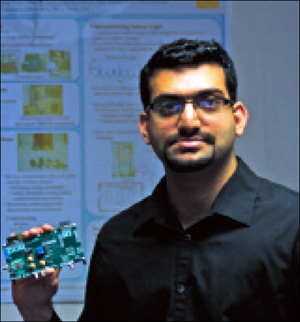The Make Fashion event in Calgary, Canada, was created to pair talented local designers with tech enthusiasts, to explore the convergence of cool clothing and cutting-edge technologies. The second annual fashion gala, held on March 1, featured a unique jacket that had a dancer lighting up—literally—when she got close to her partner.
“For the Make Fashion event in 2013, I created a dress with an accelerometer and LEDs that lit up in response to the dancer’s movements,” says Laura Brett Dempsey, a designer completing her Master of Design in strategic foresight and innovation at OCAD University, in Toronto. “This year, I wanted to take it a step further and create an outfit that would respond to the dancer’s partner.”
Make Fashion cofounder Shannon Hoover introduced Dempsey to Benjamin Reed, a product design specialist in the Radio Frequency Identification Application Development Lab (RADLab) at SAIT Polytechnic, in Calgary.
Reed had worked on a number of projects with RF technologies. For the fashion event, he considered Bluetooth, Wi-Fi-based real-time location technology and computer vision, but after some experimentation concluded that passive ultrahigh-frequency RFID would be most effective.
“We placed a ThingMagic reader module in the dancer’s jacket, near the small of her back, and wired antennas into each sleeve, as well as the front and back of the jacket,” Reed says. They sewed the LEDs into the garment and outfitted the dance partner with 12 passive UHF Frog 3D tags from Smartrac Technology.
Reed and the RADLab team developed software enabling a small external Linux computer to use the reader’s received signal strength indicator (RSSI), which shows the strength of the signal from the tag to a specific reader antenna, to determine which set of LEDs should light up. “We programmed the computer to trigger the LEDs on a specific side of the jacket to light up when that side was closer to her dance partner,” Reed says. “This is not something anyone would wear at this point, but it could be as the technology gets even smaller.”
The jacket worked flawlessly and drew an enthusiastic response from the roughly 400 fashion show attendees. To further demonstrate RFID’s capability, Reed distributed some 80 tags with color indicators stored in their memory to those at a reception after the show. When the dancer got close to anyone with a green tag, her jacket lit up green; when she neared anyone with a blue tag, it turned blue.
“A huge part of what Make Fashion is all about is the collaboration between technologists and designers,” Dempsey says. “I had a vision, and they made the magic happen.”


